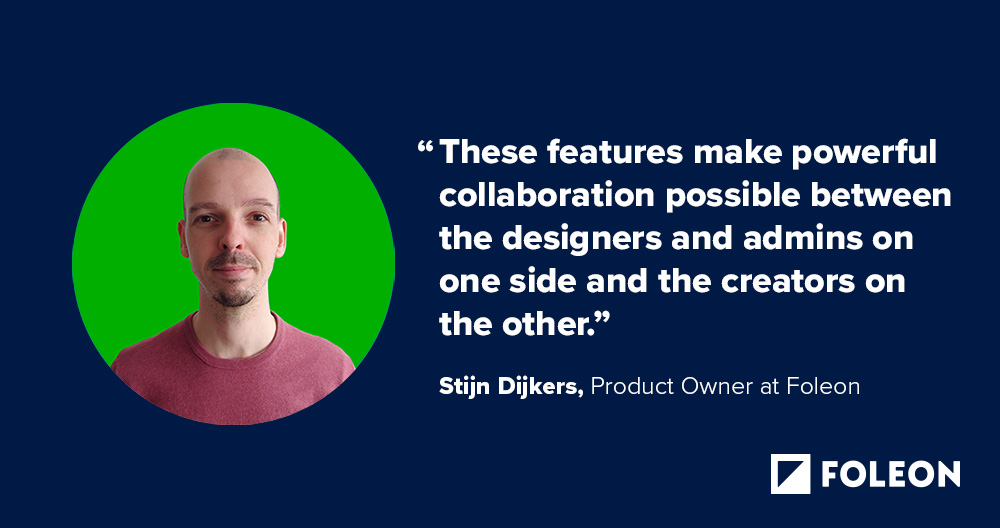You want to do more with less. We get it.
That’s why Foleon has an entire product team adding and improving features to help companies ramp up content output. Creating killer interactive content is one thing — doing so at scale is where the real magic happens.
And now it’s easier than ever. We recently launched several new features to help you collaborate between teams and create content in a more scalable way.
Just released are:
- Brand new user roles
- Cross-workspace shared media libraries
- Cross-workspace shared templates
To learn more about what’s new and what it all means for you, we turned to Stijn Dijkers, one of Foleon's product managers.
Q: Hi, Stijn. To start with, could you tell us a bit about yourself and your role here at Foleon?
Thanks, for inviting me. Yeah. I started at Foleon about a year ago as a product manager for our collaboration product module.
I do three things in this role: I identify customer challenges and opportunities to improve the product. I prioritize those improvements. And I drive the design for the solution direction. And I then also shepherd the implementation of those improvements.
I'm specifically assigned to the collaboration module because it's such a big part of our product development efforts.
It's clear from our customers that collaboration is becoming more and more critical for the content creation process. That's why we allocate so much capacity to it. My role is to ensure we spend our resources on those topics that are most valuable to our customers and that we build things in the right way — in a way that brings the most value.
Q: So, tell us why collaboration and scaling are such a big deal.
Content creation has changed considerably since Foleon was founded in 2015. We see content professionalization and democratization, which have enormously impacted upscaling content.
Our customers have more content production needs because content marketing overall is becoming more important. It's become more competitive, too; it's way harder to stand out these days. At the same time, marketing teams are expected to do everything themselves.
There's less outsourcing to external agencies, which means that our customers need to do things smarter. They distribute tasks within the content creation process themselves and care more about their own brands. They also know how to rely on internal subject matter experts for thought leadership.
And, of course, content democratization. Everybody is a creator these days. So, we want to enable everyone in a company to contribute to content creation safely.
Q: Can you tell us briefly what's included in this new release?
Sure. We recently released a suite of features for scaling content creation: Additional user roles, shared templates, and a shared media library.
We used to have three user roles in Foleon: admin, publisher, and editor. Now, there's a designer role and an author role too. This gives our customers much more granular control. They can make sure everyone is involved in the right way, and the right people have access to the right things. The new author role, for example, is only allowed to make copy changes.
The new shared media library allows people to share media assets across workspaces. There was a lot of manual curation across different workspaces in the past. But now, we've centralized things in a way that empowers designers and admins to distribute their branded media. This makes it easier to guarantee that the customer's content stays on brand.
And then shared templates are the third new feature that we recently released. It enables the designers and admins to share branded templates across workspaces without doing any double work.
These three features make powerful collaboration possible between the designers and admins on one side and the creators on the other. It allows them to create excellent content together without worrying about the brand.
Q: What exactly are workspaces in Foleon and why are they so valuable?
Workspaces are at the center of what collaboration in Foleon means. For our customers, the content creation process is not just the responsibility of one person or team. Instead, our customers create content with people across teams and departments, and workspaces facilitate that.
We built workspaces so admins can assign people to different environments, depending on the context. Those groups might be transpersonal teams, departments, brands, or even locations. The administrator then can manage all of that from a central location.
This allows for workspace-specific content creation to happen in parallel. So it kind of keeps things separated and compartmentalized.
And now, our latest features create bridges between these workspaces so that it's easier for the administrators and designers to share between them.
You leverage all the hard work done centrally by a designer or admin. Then you empower the content creators in their local workspaces to create content within the appropriate limits.
In a nutshell, it's our answer to our customers' need for controlled scaling of content creation. It ties in nicely with the emergence of content operations, which is becoming a more critical role in content teams everywhere.
Q: How do the new shared templates and media library work?
Internally, we have a project called "customer zero." It’s the way we use Foleon ourselves to manage our own brand. Essentially, we are our own prototype customer.
How things work for us, is that our creative director, Vincent, creates some branded components, media assets, and templates. He prepares fonts and all that, and he prepares them in one central workspace. And from there, he can then share those components with all workspaces.
For the people in those workspaces, then, they can always rely on that one trusted location where they know Vincent is curating and preparing those components. No matter what workspace they're in, creators don't have to worry about whether they're using the correct versions of logos, or the most up-to-date templates, for example.

Q: So for people who manage the brand, how does this make their lives easier?
We saw some challenges around how people used workspaces and branded templates in the past. It was too easy for creators to accidentally change templates, move them, rename them, or delete them.
Of course, Vincent, as a Creative Director, has a strong need to make sure that all templates are correctly curated, and only he and our administrators should be able to touch them. Those who are creating should be able to trust that that's okay and use them.
So, the new shared template system now tackles this problem. Creators can use, but can't change, these centralized brand assets.
The other challenge we saw was that media libraries would get quickly cluttered. Because each workspace had its own media library, it wasn't easy to keep each one consistent. Of course, this is only natural; with so many people collaborating, things would get moved, people would upload stuff into the wrong folder, etc.
But with the new shared media library, this is solved. Vincent now only has one repository to worry about, a central place for him to work. He doesn't have to copy things over and keep track of updates in many places. And when everything is well-organized, it stimulates creators to use the correct assets.
Q: What about people in customer-facing roles, salespeople, for example. How do these new features further empower them?
Yeah, that's the other side of this whole story. For Vincent, it's more efficient curation and a tighter grip on branded content.
But for the creators, on the other side, this suite of new features empowers them to create with all the freedom they should have. It means they don't have to wait all the time for marketing or communications to create or sign off on their content.
Companies can add colleagues from various teams and give them an author role, for example, to create, say, commercial proposals while not being able to mess with media assets or templates.
Creators can trust that they'll be able to find all up-to-date brand components in one place. And that speeds up content creation and boosts trust between creators on one side and designers and content managers on the other.
Q: Can you give an example of how we as a company use these new features?
Yeah, I like the “customer zero” project. It forces us to put ourselves in the shoes of our customers. To drink our own champagne, if you will. So, internally, we decided to pursue some of these best practices and implement them for our workspaces, roles, templates, and media assets.
We create workspaces per team. For example, we have one workspace for our sales team and one for our marketing team. Sales creates lots of commercial offers and that kind of stuff. Our marketing team, obviously, makes marketing assets.
Then we have a central workspace we call "branded" where our content managers like Jerry, our contents ops manager, and our creative director Vincent oversee the other workspaces.
From there, Jerry and Vincent manage our media asset folders and organize them in ways that work well for our different use cases. They make it easy for creators to find appropriate background videos, logos, or photos of colleagues.
And they use a similar approach to our templates. They use custom categories for templates to indicate which ones are most useful to which teams and for which use cases.
Q: So what's next — what can we expect from Foleon in the future?
We're in the final stretches of a vast under-the-hood architectural upgrade. We're improving the performance of the editor and the live Docs, which will also lead to higher scores in search engines, for example. This is going to come before the end of Q2.
But personally, I'm most excited about the future beyond that. This architectural upgrade will speed up the development of a host of future enhancements.
It's a jumping board for other future building blocks where we are preparing many improvements that our customers have been asking about. And I'm very excited to start working on this.
Want to learn more about these new features? Check out our recorded webinar here.
Also, take a look at how some of our customers scale content with Foleon:

